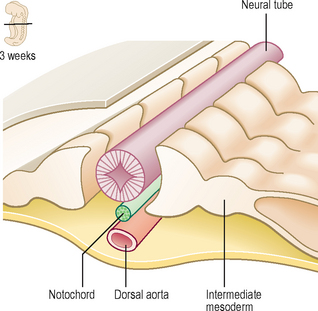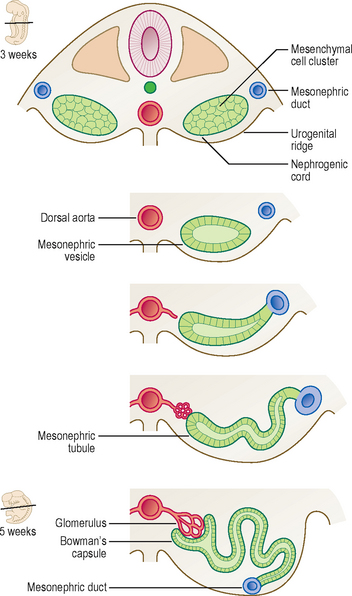Chapter 8 The urinary system
Origins
The UG system originates from the bilateral intermediate cell masses of the intra-embryonic mesoderm (Fig. 8.1). Each cell mass develops craniocaudally in the trunk of the embryo as the nephrogenic cord that underlies the urogenital ridge, the bulge formed by the underlying differentiating mesenchymal tissue. Cavities appear in the mass at each segmental level, beginning at the most cranial end, which are primitive kidney tubules. On each side, the most cranial components constitute the pronephros and these develop first, then the mesonephros develops and finally the metanephros appears most caudally (Fig. 8.2). The pronephros is non-functional and temporary, whereas the mesonephros and metanephros produce urine. There is a common pattern for kidney development within vertebrates generally, though the extent to which the pronephros, mesonephros and metanephros subsequently develop varies within different species. The metanephros becomes the definitive human adult kidney.

Fig. 8.1 Transverse section through a 3-week-old embryo showing the position of the intermediate mesoderm.
The urinary system
Two components are necessary for the development of an excretory system: a capillary bed from which the filtration product is derived and a tubule to conduct filtration products to the exterior (Fig. 8.3). The tubule begins as a blind-ended cup-like structure invaginating the capillary bed (or glomerulus) and opens into the exterior (via a convergent series of tubes into the urinary bladder). Thus, there is a nephric vesicle (becoming known as either mesonephric or metanephric as differentiation proceeds) and an excretory duct developing from the mesenchymal cells of the intermediate cell mass. The nephric vesicle is the initial part of the tubular system into which the glomerulus invaginates. The tubule opens into the duct (Fig. 8.3) and this pattern occurs at each segmental level. Each tubule lengthens and therefore becomes convoluted, especially so in the metanephros in which the definitive adult nephrons develop.





